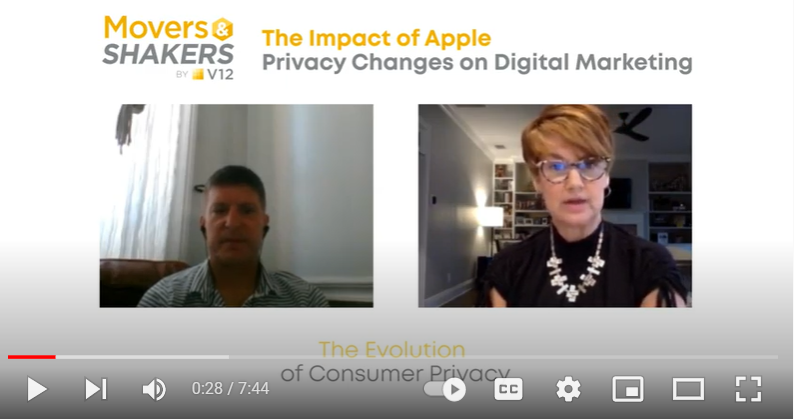Welcome to the Movers and Shakers podcast. Join us as industry leaders and experts discuss important marketing topics and share actionable insights and unique perspectives on the latest marketing, strategies, technology, and trends.
*This content has been adapted from our full-length Movers and Shakers podcast, The Impact of Apple Privacy Changes on Digital Marketing.
Luci:
What do you do to prepare? I think of some of the businesses that are having more difficulty but also the B2C brands that are ahead. They have loyalty programs and constant interaction with their consumers. And they have the ability to easily access this permission-based, first-party data. But thinking of CPG types of products. I’ll be really bland and, say, laundry detergent. We really love those types of companies but they don’t have a lot of access to first-party data. They’re selling through other channels and they’re more of a B2B2C model.
There are somewhat natural winners and losers in this because some brands just have more direct access to their customers then than other businesses do. So what should marketers do? How should they respond?
Todd:
We mentioned how digital cookies are going away to identify anonymous consumers. Now if users are logged in, that’s a different type of identity with more consent from that logged-in user. They are consenting by telling that publisher or that brand, “this is who I am and you can find me there.”
Brands need to react to that. If you have assets rooted in first-party data and you know who consumers are, where they live, and how to contact them, brands will always be able to then advertise to them through those consented networks. However, it’s not the same scale that we saw before.
And to your point, it’s important then for brands to also think of what’s happening, even if they haven’t had that 1:1 relationship with their customers. Maybe it’s now time to think about ways to develop that. Perhaps it’s by implementing programs such as newsletters, loyalty programs, or some other type of tactic.
I think advertisers will evolve their communication strategy and find something that’s relevant so brands can at least identify those top-tier or high-value consumers and interact with them safely, consistently, and predictably.
So companies will be investing in those first-party data systems, whether it’s by developing programs to acquire the rights to those consumers or by using companies like Porch Group Media. It’s probably a combination of both but it will be an investment by those brands. The benefits of those investments will be seen in what we call match results or higher KPI qualifications. It’s sales attribution versus market share estimation or a brand effect study. It’s KPIs tied directly to your top line and your bottom line.
That’s how brands will have to start thinking about it. It’s rooted in what we’ve seen coming for a while which is this convergence of martech and ad tech.
Ad tech, and I will simplify it, is a way of media planning that specifies types of content to attract certain consumers, maybe by age and demo breakout. So that is my core consumer and knowing that I will target those media properties. It’s a way of loosely qualifying that you’re reaching the right audience and that those impressions are being seen.
Martech was more performance-driven. It’s about knowing exactly who this person is because I’m sending them a very expensive direct mail piece, maybe a catalog, or maybe an email and I’m going to ship a product directly to that consumer.
So I need high-quality data – the right name and address, identity-rich information in order to decide whether or not to market to them.
Well now adtech and martech are coming to the same playing field. We talked about those digital ecosystems and walled gardens. But there’s linear TV which is being replaced by Connected TV, YouTube, Facebook, Amazon, and Snap and which are broadcasting content. They are disrupting the landscape.
I think when those two things come together, ad tech and martech will merge as one and be rooted in rich consumer identity. Investments will be in understanding the important descriptive elements behind it, and the process and discipline of making sure that marketing programs are being activated against that data that is of a higher standard. That’s the future
Luci:
Connected TV companies have really developed these rich datasets of first-party data so they can build their various audiences and be really prepared for that addressable advertising wave. I’ve been really impressed with how some of those companies were prepared and have been executing on these really purposeful audiences. It’s really impressive how they were able to quickly shift, especially during Covid, although I know they were preparing for it for years for various reasons.
I think some of these privacy issues have really helped spur this along as well.
Todd:
I couldn’t agree more because essentially when you invest in first-party data and understand that consumer and their identity through log-in information, that’s the currency of connected TV.
If you look at some of the consolidations that are going on, you are seeing combinations of what would be programmatic DSPs, which are more open inventory, inventory on the open web combined with connected TV inventory in anticipation that signed-in traffic is going to be at a premium. There’ll be less of it. Where can I get more inventory? Connected TV has been telling that story – and they can help replace some of those analytics because it’s not about the Nielsen ratings anymore, it’s about the consumer that’s watching your content.
Movers & Shakers Podcast by Porch Group Media
Subscribe below to stay tuned for upcoming episodes with other industry-leading marketing executives.
Stay up to date with the latest news and resources:





